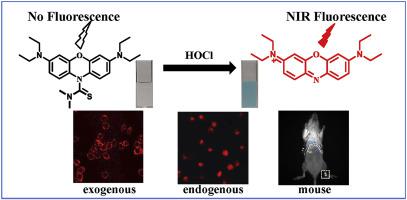Our official English website, www.x-mol.net, welcomes your
feedback! (Note: you will need to create a separate account there.)
A novel near-infrared fluorescent probe based on phenoxazine for the specific detection of HOCl
Journal of Luminescence ( IF 3.3 ) Pub Date : 2020-10-01 , DOI: 10.1016/j.jlumin.2020.117460 Jiajia Yang , Wubin Zheng , Yang Shen , Yunze Xu , Guanglei Lv , Chunxia Li
Journal of Luminescence ( IF 3.3 ) Pub Date : 2020-10-01 , DOI: 10.1016/j.jlumin.2020.117460 Jiajia Yang , Wubin Zheng , Yang Shen , Yunze Xu , Guanglei Lv , Chunxia Li

|
Abstract Among the diverse reactive oxygen species (ROS), hypochlorous acid (HOCl) plays an essential role in various biological processes. However, superfluous or uncontrollable hypochlorous acid can result in tissue damage and trigger a series of inflammation-associated diseases. Therefore, it is greatly urgent to develop highly efficient fluorescent probes for the detection of HOCl. Here, a novel near-infrared (NIR) fluorescent probe BR-1 is designed and synthesized through connecting N,N-dimethyl-thiocarbonyl (DMTC) group to the phenoxazine skeleton via one-pot approach to sense and image HOCl. Although DMTC exhibits significant sensitivity and fast response towards HOCl, it suffers from great interference from Hg2+ owing to the existence of sulfur atom. Interestingly, the probe BR-1 displays excellent anti-interference against Hg2+ when DMTC is linked to the phenoxazine skeleton. In addition, BR-1 shows quick response, high sensitivity and selectivity towards HOCl both in vitro and in vivo. Moreover, BR-1 is capable of rapidly detecting and imaging endogenous HOCl in the inflammation area from the mouse models of arthritis.
中文翻译:

基于吩恶嗪的新型近红外荧光探针特异性检测HOCl
摘要 在多种活性氧 (ROS) 中,次氯酸 (HOCl) 在各种生物过程中起着至关重要的作用。然而,过量或无法控制的次氯酸会导致组织损伤并引发一系列炎症相关疾病。因此,开发用于检测HOCl的高效荧光探针迫在眉睫。在这里,通过一锅法将 N,N-二甲基硫代羰基 (DMTC) 基团连接到吩恶嗪骨架,设计并合成了一种新型近红外 (NIR) 荧光探针 BR-1,以感知和成像 HOCl。尽管 DMTC 对 HOCl 表现出显着的灵敏度和快速响应,但由于硫原子的存在,它受到 Hg2+ 的很大干扰。有趣的是,当 DMTC 连接到吩恶嗪骨架时,探针 BR-1 对 Hg2+ 显示出出色的抗干扰性。此外,BR-1 在体外和体内均显示出对 HOCl 的快速响应、高灵敏度和选择性。此外,BR-1 能够从关节炎小鼠模型中快速检测和成像炎症区域中的内源性 HOCl。
更新日期:2020-10-01
中文翻译:

基于吩恶嗪的新型近红外荧光探针特异性检测HOCl
摘要 在多种活性氧 (ROS) 中,次氯酸 (HOCl) 在各种生物过程中起着至关重要的作用。然而,过量或无法控制的次氯酸会导致组织损伤并引发一系列炎症相关疾病。因此,开发用于检测HOCl的高效荧光探针迫在眉睫。在这里,通过一锅法将 N,N-二甲基硫代羰基 (DMTC) 基团连接到吩恶嗪骨架,设计并合成了一种新型近红外 (NIR) 荧光探针 BR-1,以感知和成像 HOCl。尽管 DMTC 对 HOCl 表现出显着的灵敏度和快速响应,但由于硫原子的存在,它受到 Hg2+ 的很大干扰。有趣的是,当 DMTC 连接到吩恶嗪骨架时,探针 BR-1 对 Hg2+ 显示出出色的抗干扰性。此外,BR-1 在体外和体内均显示出对 HOCl 的快速响应、高灵敏度和选择性。此外,BR-1 能够从关节炎小鼠模型中快速检测和成像炎症区域中的内源性 HOCl。











































 京公网安备 11010802027423号
京公网安备 11010802027423号